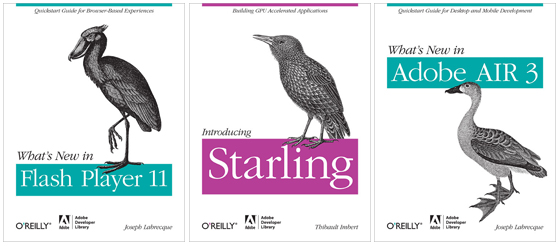O’Reilly recently released three new Flash related e-books, and the brilliant news is that they’re all available for free. First up there’s What’s New in Adobe AIR 3 and What’s New in Flash Player 11, both of which are by Joseph Labrecque, who is also the author of the excellent Flash Development for Android Cookbook. The third book, Introducing Starling by Thimbault Imbert, is for all those interested in taking advantage of Flash’s Stage3D APIs to create hardware accelerated 2D graphics.
Joseph Labrecque’s titles do an excellent job of detailing the new features present in Flash Player 11 and AIR 3. Both books cover the recent graphics and video additions, including the API improvements, new external image capabilities and, of course, a discussion of hardware accelerated graphics rendering using Stage3D. Although Stage3D is clearly not the focus of either book, some time is spent providing code examples of it being used in conjunction with the high-level Away3D and Starling third-party libraries.
Two other extremely welcome additions to the Flash platform are H.264 video and native JSON support, both of which are also covered. There’s also plenty for mobile developers, with native text, hardware accelerated video, camera, speaker and encrypted local storage all featuring. Considering it’s not always easy to discover what’s new with each new major release, both “What’s New” titles should be considered essential reading.
As for Introducing Starling; given it’s depth, it’s ridiculous to think that Thibault Imbert’s offering is actually free of charge. A port of the popular iOS Sparrow library, Starling is an ActionScript 3 2D framework that has been developed on top of Adobe’s Stage3D APIs in order to provide lightning fast GPU-accelerated games and applications. The book covers everything you need to know in order to get up and running, gently introducing the reader to the many important concepts, the distinctions between Starling and Flash’s traditional display list, and also the similarities between the two.
By the end of the book you’ll be comfortable working with sprite sheets, be able to programatically create bitmap-based animations, and have a firm grasp of Starling’s event model. There’s also an introduction to particles, and some space dedicated to the integration of Box2D, and Robotlegs. I managed to spend some considerable time with this book when learning the Starling framework and it really was an invaluable resource. If you’re developing for iOS and Android then this will be vital reading when Stage3D rolls out across these platforms.
So there you have it. Three excellent books and all available free of charge! I’m not entirely sure where Thibault Imbert and Joseph Labrecque find the time and energy, but I’m grateful they do. There’s really no excuse for not popping over to the O’Reilly site and downloading these three gems.
